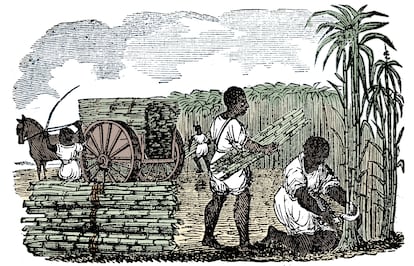The Underground Railroad of the south: The unknown story of the slaves who fled to Mexico
Historian Alice Baumgartner connects the Civil War with the abolition of slavery in its neighboring country: ‘Lincoln and Juárez’s alliance contributed to strangling the Confederacy’


The captain of the Metacomet discovered the desertion of the Frisby brothers, George and James, when in the summer of 1857 the steamboat was preparing to return from Veracruz to New Orleans for more cotton. The man alerted the police, but he left out one piece of information: the Frisbys were black, the property of a Louisiana plantation owner. According to the recently approved Constitution, any slave became a free man when they set foot in Mexico, whose Congress had abolished human slavery in 1837. George was quickly arrested. James was better at hiding, but most importantly, he told his story to the authorities when they finally found him. That’s why they didn’t send him back to the Metacomet despite the formal complaint of the U.S. ambassador.
The Frisbys’ story is one of many that the American historian Alice L. Baumgartner, a professor at the University of Southern California, recalls in South to Freedom: Runaway Slaves to Mexico and the Road to the Civil War. The book reveals that there was also an Underground Railroad in the southern U.S., a network of homes and people who helped fugitives escape to Mexico from the slaveholding states of Texas, Louisiana and North Carolina. The book analyzes how the end of slavery in Mexico precipitated the debates in the U.S. that resulted in the Civil War.
The southern route was not as well-known as the northern one. It was not as commonly traveled; Baumgartner calculates that, while 3,000-5,000 fugitives crossed into Mexico, between 30,000 and 100,000 crossed the Mason-Dixon Line.
“It was easier up north. Those who left the slaveholding states further north — Maryland, Virginia and Delaware — had better help, but they also had a more difficult future,” the historian explained recently in the elegant library of the Mexican Cultural Institute in Washington, where the day before she spoke about her book as part of the bicentennial celebration of the diplomatic relationship between Mexico and the U.S. “In high school, we all learned about Harriet Tubman and the myth of a route of houses with candles in the windows where enslaved people could take refuge. That myth says that it was a network formed fundamentally by whites, while there were also free Blacks who were essential. Those ideas have been reconsidered recently.”
Whichever direction they went, they faced slavery and the risk of being kidnapped. In Mexico, where they arrived with falsified permits from their owners, they wore wigs to pass for being white and rode stolen horses. They had two options: join the militias that defended the Northeast border from the incursions of Indians or integrate into the lowest ranks of the labor force. “There is evidence in the archive that some were capable of claiming land and citizenship. That didn’t happen in the north, where they enjoyed what Frederick Douglass called a ‘doubtful freedom.’ In this struggle between the right to property and the right to freedom, the former tended to be imposed, even in the anti-slavery regions of the United States. There was a debate about whether descendants of Africans could be considered full citizens,” she explains.
Baumgartner began to write her book in 2012, without knowing that she would have the help of the author Colson Whitehead, who in 2017 wrote a homonymous book about the Underground Railroad. The book won Whitehead a Pulitzer, and Barry Jenkins later adapted it to television. The historian had chosen the topic because of the case of Haiti. After the revolution against the French, the country outlawed slavery in 1804 and in 1819 passed a law that gave freedom to anyone who set foot in its territory. That provoked turbulence in the neighboring country, leading Baumgartner to delve into the consequences that Mexico’s decision to abolish slavery had in the United States, particularly after the conquest of Texas in the war of 1848. “In 1837, Congress prohibited slavery in the whole country. That abolition policy raised morale among Mexicans, galvanizing international support for the country,” she writes. “Without that decision, which made slaveholders nervous,” she says, “the Texas Revolution may never have happened, and who knows if that territory would still remain Mexican. I agree with [the historian] Enrique Krauze when he says that, to the list of the original sins of my country, slavery and the genocide of Native people, we have to add a third: the seizing of Mexican territories.”

The connecting of those two points is perhaps the greatest strength of the book, which takes an uncommon path: telling the stories of the countries as an interconnected narrative. “Many were surprised by that when I published it. They had trouble admitting that Mexico had a role in the United States’ debates about slavery.”
‘Bad hombres’
It was, she explains, another expression of the condescension with which her countrymen are used to regarding the south. “There were many moments when I was looking at the sources from the 19th century when I couldn’t avoid thinking about what I was seeing on the news everyday. For example, when Trump started with the rhetoric that the Mexicans were ‘bad hombres’ and rapists, or when he said that he would make them pay for the wall. It reminded me of that American politician [Jacob W. Miller, a congressman from New Jersey] who said that Mexico would pay for the war against the United States with its own territory. I was interested in the history of the 19th century because it seemed like a very different place from modern life, but at times they are disturbingly similar.”
Baumgartner explains that the viceroyalty of New Spain was always much more diverse than the United States and, in a certain sense, more advanced. “The demographic differences explain the different approaches to the racial issue in both places. In 1810, there were 10,000 slaves in New Spain, compared to approximately a million in the United States,” she recalls. In the book, she laments that this disparity leads her country’s historians to conclude, falsely, that Mexico abolished slavery in 1837 because it was easier, given that its slave population was declining. “I think that decision was taken for humanitarian and political reasons, but above all it was made with Texas in mind, as a way to stop the colonizers.”
The book, which covers the period until 1867, also touches on the adventures of some of the 19th century’s protagonists. Among them is Vicente Guerrero, the rebel leader in the war of independence with Spain and descendent of African slaves who, during his brief presidency of Mexico, abolished slavery by decree in 1829, and Abraham Lincoln, who as a congressman was opposed to the war with Texas. Benito Juárez, whose effigy appears on a mural at Washington’s Cultural Institute, also appears.
“The alliance of Lincoln and Juarez helped strangle the Confederacy,” Baumgartner says. “And there the fascinating figure of the diplomat Matías Romero, the Mexican representative in the United States, is essential. He was the first foreign envoy to congratulate Lincoln after winning the presidency. There began an interesting relationship between both, which appears in their letters. Romero, from the beginning, saw what Lincoln would only later realize: that Mexico and the United States had a shared commitment to equality and freedom, and that could be the base of cooperation between Juárez and Lincoln’s governments.”
That, the author believes, was one of the defining moments of the relationship between two countries separated — and divided — by almost 2,000 miles of border, and condemned to understand each other. The relationship can still be described by the common phrase attributed imprecisely to Mexican president Porfirio Díaz: “Poor Mexico, so far from God and so close to the United States.”
Sign up for our weekly newsletter to get more English-language news coverage from EL PAÍS USA Edition
Tu suscripción se está usando en otro dispositivo
¿Quieres añadir otro usuario a tu suscripción?
Si continúas leyendo en este dispositivo, no se podrá leer en el otro.
FlechaTu suscripción se está usando en otro dispositivo y solo puedes acceder a EL PAÍS desde un dispositivo a la vez.
Si quieres compartir tu cuenta, cambia tu suscripción a la modalidad Premium, así podrás añadir otro usuario. Cada uno accederá con su propia cuenta de email, lo que os permitirá personalizar vuestra experiencia en EL PAÍS.
¿Tienes una suscripción de empresa? Accede aquí para contratar más cuentas.
En el caso de no saber quién está usando tu cuenta, te recomendamos cambiar tu contraseña aquí.
Si decides continuar compartiendo tu cuenta, este mensaje se mostrará en tu dispositivo y en el de la otra persona que está usando tu cuenta de forma indefinida, afectando a tu experiencia de lectura. Puedes consultar aquí los términos y condiciones de la suscripción digital.
More information
Archived In
Últimas noticias
Welcome to the post-religion era: The idea of Christianity as the absolute truth has become obsolete
‘I thought you would like it’: The risky sexual practice popularized by TV shows and TikTok
The digitalization of tourism: ‘They promise experiences and gave us the worst possible one’
Mexican peso defies uncertainty with forecasts of a new period of stability in 2026
Most viewed
- Sinaloa Cartel war is taking its toll on Los Chapitos
- Reinhard Genzel, Nobel laureate in physics: ‘One-minute videos will never give you the truth’
- Oona Chaplin: ‘I told James Cameron that I was living in a treehouse and starting a permaculture project with a friend’
- Why the price of coffee has skyrocketed: from Brazilian plantations to specialty coffee houses
- Silver prices are going crazy: This is what’s fueling the rally










































